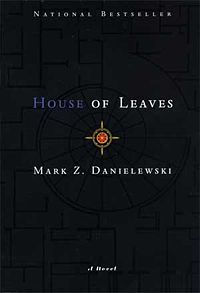 I try not to steer people away
I try not to steer people away
from reading anything,
but I cannot keep from issuing
a warning about this book.
Warning: Do not read this novel
if you hate footnotes
or stories that involve a lot of effort on
the part of the reader.
That being said . . . read this book. I know, I’m being confusing, but I’m just going along with the tone of the tale. This book doesn’t make sense–it’s not supposed to. At least I don’t think it is. Some have labeled this a satire of academic criticism and I can see where that idea comes from. House of Leaves is what you call ergodic literature–a big, fancy word for hard-to-read. Filled with footnotes about footnotes of other footnotes; words crawling across the page in myriad styles, shapes, and colors; and several appendices, Leaves is not an easy read by any means, but finishing it brings a sense of satisfaction that the modern romance novel or murder mystery could never garner.
The main story, based off of a video called The Navidson Record, tells the tale Will Navidson, his partner Karen Green, and their two children as they move into a new house, only to find the unexplained happening–their house grows. For those familiar with the TARDIS of Doctor Who fame or the camping tents from Harry Potter (books 4 & 7), the idea of something bigger on the inside than the outside may not seem that strange or spooky, but actually living in a house that grows and changes while still appearing the same on the outside may be a bit unnerving.
The Navidson Record is a video shot and edited by adventure photographer Will Navidson when he finds a mysterious hallway that appears in between the master and children’s bedrooms. It disappears after only a few days, only to reappear in their living room, looking, for all appearances, to lead out into the backyard. This hallway grows and shrinks of its own accord, adding rooms the size of closets and ballrooms alike, all made of the same light-sucking black material. Several expeditions are made into the depths of the hallway, against the wishes of Karen, culminating in several deaths and the eventual ending of the hallway. The psychoses of all of the characters are enhanced by this unimaginable space, which to me is the more interesting aspect of the story. Watching how each person deals, or refuses to deal, with the hallway is what leads to the rest of the novel.
The middle layer of the novel, which encompasses the first, deals with the blind Zampanò, who finds a copy of The Navidson Record and chooses to write a critical analysis of it, replete with footnotes, accompanying text, and less coherency as the review progresses–all amazingly detailed considering the author’s lack of sight.
Layered on the outside of Zampanò’s review is the story of Johnny Truant, the young man who finds and becomes obsessed with the blind man’s analysis. Truant’s tale is told in the footnotes, as he adds to what the blind man has written, stuffing in anecdotes of his own journey to discover the veracity of the video.
Warning #2: House of Leaves is not for the faint of heart. Its label as a horror story is enough to put some people off, but little of the book actually frightened me. My warning, rather, is for those squeamish of graphic language and various sex scenes. Johnny Truant is rough and a bit amoral to begin with, but he self-admittedly runs away from his obsession with the Navidson house’s mystery via drugs, alcohol and sex (although he does swear off of it all when he realizes nothing has helped). Many say that language and sex is just a consequence of Hollywood’s influence and isn’t necessary to tell a good story. In many cases, I would agree with that, but in this story it really fits.
The real horror of the story is seeing what this house does to its inhabitants and others sucked into the mystery. The levels of psychosis and depravity reached by the characters really is horrendous–all in a fruitless effort to remove the house from their minds. Just as in the way the hallway winds and slithers its way into the depths of the earth, it slithers and winds into the depths of peoples’ minds, grabbing hold and refusing to let go.
Perhaps it’s just my love of modern and post-modern lit, but I really enjoyed reading House of Leaves. Yes, I skipped some of the footnotes (particularly those that labeled pages of names or random words) and yes, I didn’t read all of the appendices, but I truly appreciated the story that unfolded through the labyrinthine words on the pages. Although about a house, this tale is truly a character study. I learned more about the characters than I thought possible through footnotes and edits to the text.
Is it pretentious? You bet. Is it long? No doubt. But does it tell a story? In ways you never thought possible. For all that’s working against it, House of Leaves just plain works. Try to figure it out if you must, but be warned of what might happen if you delve too deep. You just might find yourself unable to climb your way out again.
This post was brought to you courtesy of the holiday Halloween. Be safe, trick-or-treaters!
Age recommendation: Adult (it really is that confusing)
Rating: 8.5 out of 10 stars
Reviewed by: Meagan


